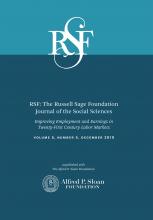Research Article
Open Access
Gender in the Labor Market: The Role of Equal Opportunity and Family-Friendly Policies
Elizabeth L. Doran, Ann P. Bartel, Jane Waldfogel
RSF: The Russell Sage Foundation Journal of the Social Sciences December 2019, 5 (5) 168-197; DOI: https://doi.org/10.7758/RSF.2019.5.5.09
Elizabeth L. Doran
aA doctoral candidate at Columbia University School of Social Work
Ann P. Bartel
bMerrill Lynch Professor of Workforce Transformation at Columbia Business School
Jane Waldfogel
cCompton Foundation Centennial Professor for the Prevention of Children’s and Youth Problems at Columbia University School of Social Work

REFERENCES
- ↵
- Million for Worker Flexibility
- ↵
- Ahn, Haksoon
- ↵
- Bartel, Ann,
- Charles L. Baum,
- Maya Rossin-Slater,
- Christopher J. Ruhm, and
- Jane Waldfogel
- ↵
- Bartel, Ann,
- Maya Rossin-Slater,
- Christopher Ruhm, and
- Jane Waldfogel
- ↵
- Baum, Charles L., and
- Christopher J. Ruhm
- ↵
- Bedard, Kelly, and
- Maya Rossin-Slater
- ↵
- Bertrand, Marianne,
- Claudia Goldin, and
- Lawrence F. Katz
- ↵
- Black, Sandra E.,
- Diane Whitmore Schanzenbach, and
- Audry Breitwieser
- ↵
- ↵
- ↵
- Blau, Francine D., and
- Anne E Winkler
- ↵
- Boushey, Heather
- ↵
- Budig, Michelle
- ↵
- Budig, Michelle, and
- Paula England
- ↵
- Budig, Michelle, and
- Melissa J. Hodges
- ↵
- ↵
- Chaudry, Ajay,
- Taryn Morrissey,
- Christina Weiland, and
- Hirokazu Yoshikawa
- ↵
- Chung, YoonKyung,
- Barbara Downs,
- Danielle H. Sandler, and
- Robert Sienkiewicz
- ↵
- ↵
- Craig, Lyn, and
- Killian Mullan
- ↵
- Dey, Judith
- ↵
- ↵
- Goldin, Claudia, and
- Lawrence F. Katz
- ↵
- Goldin, Claudia, and
- Joshua Mitchell
- ↵
- Gruber, Jonathan
- ↵
- Ha, Yoonsook, and
- Daniel P. Miller
- ↵
- ↵
- Herbst, Chris M
- ↵
- ↵
- Hipp, Lena,
- Taryn W. Morrissey, and
- Mildred E. Warner
- ↵
- Holzer, Harry J., and
- David Neumark
- ↵
- ↵
- Horowitz, Juliana M.,
- Kim Parker,
- Nikki Graf, and
- Gretchen Livingston
- ↵
- Klerman, Jacob Alex,
- Kelly Daley, and
- Alyssa Pozniak
- ↵
- Kleven, Henrik,
- Camille Landais, and
- Jakob Egholt Søgaard
- ↵
- Kuziemko, Ilyana,
- Jessica Pan,
- Jenny Shen, and
- Ebonya Washington
- ↵
- Laughlin, Lynda
- ↵
- ↵
- Malik, Rasheed
- ↵
- Mathur, Aparna,
- Isabel V. Sawhill,
- Heather Boushey,
- Ben Gitis,
- Ron Haskins,
- Doug Holtz-Eakin,
- Harry J. Holzer, et al
- ↵
- Milkman, Ruth, and
- Eileen Appelbaum
- ↵
- National Partnership for Women & Families
- ↵
- Organization for Economic Cooperation and Development (OECD)
- ↵
- Olivetti, Claudia, and
- Barbara Petrongolo
- ↵
- ↵
- ↵
- Rossin-Slater, Maya
- ↵
- ↵
- Stearns, Jenna
- ↵
- Thomas, Mallika
- U.S. Bureau of Labor Statistics (BLS)
- U.S. Bureau of Labor Statistics (BLS)
- ↵
- U.S. Bureau of Labor Statistics (BLS)
- ↵
- U.S. Equal Employment Opportunity Commission (EEOC)
- ↵
- Usdansky, Margaret L, and
- Douglas A Wolf
- ↵
- Waldfogel, Jane
- ↵
- ↵
- Weeden, Kim A.,
- Youngjoo Cha, and
- Mauricio Bucca
- ↵
- Weisshaar, Katherine
- ↵
- Williams, Joan C.,
- Susan J. Lambert,
- Saravanan Kesavan,
- Peter J. Fugiel,
- Lori A. Ospina,
- Erin D. Rapoport,
- Meghan Jarpe,
- Dylan Bellisle,
- Pradeep Pendem,
- Lisa McCorkell, and
- Sarah Adler-Milstein
In this issue
Gender in the Labor Market: The Role of Equal Opportunity and Family-Friendly Policies
Elizabeth L. Doran, Ann P. Bartel, Jane Waldfogel
RSF: The Russell Sage Foundation Journal of the Social Sciences Dec 2019, 5 (5) 168-197; DOI: 10.7758/RSF.2019.5.5.09
Jump to section
Related Articles
- No related articles found.
Cited By...
- No citing articles found.





